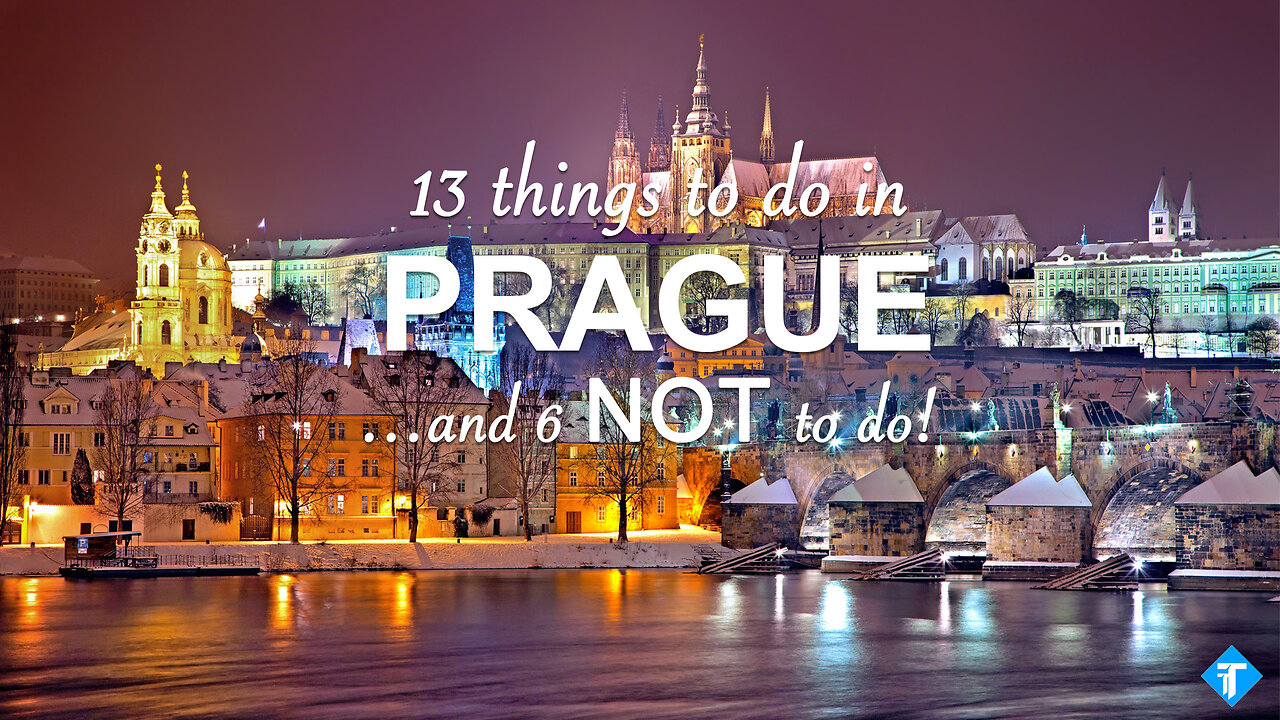Premium Only Content

13 things to do (AND 6 NOT TO DO) in Prague - Czech Republic Travel Guide
Prague is among the most visited European capitals and reading our guide it will be easy to understand why. Besides being a city of unique beauty, rich in artistic and cultural treasures, it is also a famous destination for its entertainment and a popular destination for stag and hen parties. Strolling the romantic streets of downtown, you'll find yourself among an eclectic crowd of history buffs, art lovers, and groups of friends drawn to the city's vibrant nightlife.
Prague is a city to visit at any time of the year, here you can breathe a cheerful atmosphere in the summer and a romantic one during the Christmas holidays. To make the most of every moment of your stay, we have created a list of things not to be missed on your first day in the city.
1. Carlo bridge.
Together with the Castle and the astronomical clock, the Charles Bridge is one of the symbols of Prague. This famous stone bridge was built in the 1300s and crosses the Vltava River, thus connecting the two central districts of the capital, Malá Strana and Staré Město, or the Old Town.
Charles Bridge is, above all, a place full of mysteries and legends. One of the most famous legends concerns its 30 statues: at night, when the bridge is empty, the statues come alive, becoming even more vital when a child is born on nearby Kampa Island. Another legend, more macabre, concerns the statue of San Giovanni Nepomuceno. It is said that the court priest St. John was killed by King Wenceslas IV and his remains were thrown off the Charles Bridge, right from the spot where the statue stands today.
2. St. Vitus Cathedral.
St. Vitus Cathedral is located within the walls of Prague Castle and is the most important church in the Czech capital, also known as the Prague Cathedral. But that's not all: its impressive size also makes it one of the largest cathedrals in Europe. Definitely a must see in the city!
A wonderful example of Gothic architecture, it is over 124 m long, 60 m wide and 33 m high. The bell tower also houses the largest bell in all of Prague, built in 1549, weighing 18 tons and 203 cm in height. Once inside, you can admire the large arches and the majestic stained glass windows behind the altar, but above all, don't miss the underground crypt where the sepulchres of the Bohemian kings are housed and the Crown Chamber, where the Crown Jewels are displayed, used also for the coronations of the sovereigns.
3. Prague Castle.
Almost always the protagonist of the novels of the writer Kafka, the Prague Castle is one of the most important attractions of the city and looms over the capital with its inaccessible and even slightly threatening aspect. To reach it you need to travel long steep roads but, once you get there, you can breathe the atmosphere of power, in a mix of history and legend.
In reality, the Castle is a complex that houses several buildings. Once through the great walls, you will be able to admire the wonderful Royal Palace, inside which you cannot miss the magnificent 16th century Vladislav hall, used for coronations, banquets, markets and even jousting tournaments. You will then find the Castle Art Gallery, where over 100 masterpieces are exhibited, the exhibition on Prague Castle, to learn about its entire history, and the ancient Basilica of San Giorgio, which houses the tombs of some important historical figures such as Vlatislav I, Duke Boleslav II and St. Ludmila. Finally, you will find the wonderful and famous St. Vitus Cathedral, which deserves a paragraph of its own.
4. Astronomic watch
Main attraction of the Old Town square, the Astronomical Clock is certainly one of the symbols of Prague together with the Charles Bridge and the wonderful Castle.
It is located on the south side of the Town Hall building and consists of three main elements: the astronomical dial, where you can see the time and the positions of the sun and moon; the "Corteo degli Apostoli", i.e. the mechanism which, at the stroke of every hour, allows the 12 figures represented (the Apostles to be precise) to move; and a lower dial with 12 medallions representing the months of the year.
At the stroke of every hour, a large crowd gathers under the clock to admire the famous tolling. It is a very eagerly awaited event, but perhaps a little disappointing: some decorative statuettes simply start to move. Consider whether or not you still want to watch, but be prepared to be overwhelmed by people.
5. Kafka Museum.
Franz Kafka is one of the best known writers in the world, a real credit to the city of Prague. He was born right in the Czech capital back in 1883 and for years he frequented the streets and clubs of the city.
If you love literature and in particular his texts, one of the museums that you cannot miss is certainly the Kafka Museum, located in the Malá Strana district, at the base of the castle, and overlooking the Vltava river. The museum traces Kafka's entire life and here you can admire first editions of his works, as well as personal material such as diaries, photographs, drawings, letters and even numerous manuscripts.
6. Golden Lane and Kafka's House.
In addition to the Kafka Museum, one of the writer's places not to be missed in the city is his birthplace. To be precise, it is located in the famous Vicolo d'Oro, at number 22, recognizable by its pastel blue colour. Today a small bookshop has been opened inside, where you can buy all the books of the famous Bohemian writer.
The Golden Lane is one of the most famous and beautiful streets in Prague. It is located within the castle complex and develops uphill, completely framed by many colored houses, once occupied by goldsmiths and craftsmen, who had their workshops here. It also represents one of the most instagrammable spots in the capital, don't miss it absolutely.
7. John Lennon Wall.
In addition to the Dancing House, one of the most photographed places in Prague is certainly the famous John Lennon Wall, located in the heart of the Malá Strana district.
The John Lennon Wall was born almost by chance: it seems to have been a Mexican student who drew the first graffiti and then, over the years, various works of art have overlapped, transforming an anonymous wall into one of the most surprising places, and also instagrammable, from Prague. Today this place is also a symbol of brotherhood and peace, a place to leave a small sign of one's passage through the Czech capital.
8. Mala Strana.
Malá Strana, or "small part", is the neighborhood that develops at the base of the Castle, it almost seems like a city within a city. The result of a reconstruction that took place after the great fire of 1541, thanks also to Italian artists and architects who took care of the restoration, giving this area a Renaissance and Baroque appearance.
Today Malá Strana is one of the best neighborhoods to stay in and its main street is Via Nerudova. Here you will find numerous accommodations, but also embassy headquarters and wonderful baroque palaces. Not only that: the neighborhood represents the popular soul of the city, made up of cafes, breweries and artists who perform along the streets. An area to live absolutely.
9. The Dancing House.
The city of Prague presents wonderful architecture and surprises in every corner. Walking through the streets of the New Town, in fact, you can come across the Dancing House, one of the most photographed buildings in the city.
Built in 1996, the Dancing House represents one of the pillars of modern Prague architecture and, as the name suggests, is so particular that it seems to be engaged in a bizarre dance. It is in fact dedicated to the very famous dancing couple formed by Ginger Rogers and Fred Astaire and was designed by the Czech-Croatian architect Vlado Milunic together with the Canadian architect Frank Gehry.
Inside, you will also find an art gallery where guided tours, conferences, workshops and numerous activities are organized and a French restaurant which also offers a splendid view of the city and the river.
10. Josefov, the Jewish Ghetto
One of the most fascinating districts of Prague is certainly Josefov, or the Jewish Ghetto. Located inside the Old City, overlooking the bank of the Vltava river, it is a perfect place to explore on foot (we recommend the guided tour in Italian) immersing yourself in its atmosphere and in its long and unfortunately also tormented history.
This neighborhood was inhabited by the Jewish population from 900 to 1708, also hosting some prominent figures, such as the writer Franz Kafka, Rabbi Low and his legendary Golem. Enjoy a walk through its narrow streets to discover its Synagogues, small hidden corners and, if you are interested, you can also visit the Jewish Museum of Prague, which tells the story of the Jews in the city.
11. Old Town and Church of Our Lady before Tyn.
The Old Town, in Czech Staré Město, is the second historical district of Prague. It develops on the opposite bank of the Vltava river with respect to the Malá Strana district, to which it is connected by the Charles Bridge.
The Old Town develops around the homonymous square, called Staroměstské nám, location of some of the most significant events in the city, both in the past and nowadays. Here, in fact, the sovereigns were crowned but several executions also took place. Furthermore, many events are held here today, such as the Christmas markets, among the most beautiful in Europe!
Also not to be missed is a visit to the wonderful Church of Santa Maria di Týn, one of the most beautiful in Prague. Built in 1300, it is easily recognizable thanks to its two tall towers in the Baroque style.
12. Old Jewish Cemetery.
The Old Jewish Cemetery is located in the Josef and is one of the most visited attractions in the city. It is located right in the heart of the Jewish Ghetto and we advise you not to limit yourself to admiring it from the outside, but to enter and visit it.
Founded in 1439, for a long time it was the only place where Jewish families could bury their dead: the result of this is that inside there are over 12,000 tombstones and graves, which are literally superimposed on each other. The tomb of Rabbi Low is one of the most visited, in fact it is said that it is particularly auspicious to stop for a prayer, leave the traditional stones or coins and some notes with one's wish.
13. Clementinum.
If you love ancient buildings, rich in art and history, then you absolutely cannot miss the Klementinum, the second largest architectural complex in Prague after its famous Castle. It is located in the heart of the Old Town and is absolutely worth a visit.
Founded in the 11th century, it was born when the Dominican friars, in 1232, occupied the Church of San Clemente giving view to the monastery. The building took the name of Klementinum only in 1556, when the Jesuits arrived and began the expansion and renovation works, which lasted almost 200 years. Today, it houses the National Library and is a place rich in history and culture, also hosting classical music and organ concerts.
14. 6 Warnings.
1. Don't forget a warm jacket.
The fundamental advice before departure is one: whatever the season in which you decide to leave, do not forget to pack a heavy jacket. Although the climate is typically continental, it is not uncommon for temperatures to drop drastically and in a short time, even in spring and summer.
2. Beware of abusive taxis.
Taxis are often overcrowded with tourists, especially at night. This involves the presence of several abusive taxi drivers who stop outside the most crowded places with luxurious and black cars. Be careful to be convinced: the tariff is much higher than that of an authorized taxi.
3. Don't stay long on the subway.
Also in Prague, as in many large cities, there are some less safe places: among these also the underground stations. In fact, they are often frequented by real gangs of pickpockets, so there is no need to stop for a long time, unless it is strictly necessary.
4. Don't carry around a lot of cash.
Linked to the previous point: precisely because there are so many places where you can be robbed, it is always preferable not to carry a lot of cash with you.
The less cash you have on you, the less you risk losing.
5. Beware of cigarettes.
In the Czech Republic, smoking has been prohibited in public places since May 31, 2017, the date on which the law sanctioning it came into force. Pubs, restaurants, but also metro stations are non-smoking places. Some places, however, reserve a special smoking room.
6. Don't go shopping on Karlova street.
Karlova Street is one of the best known shopping streets in Prague. And for this reason also one of those where the shops have the highest prices. It is preferable, therefore, if you want to buy souvenirs or any kind of memento, wander around a bit before letting yourself be convinced: you will probably find similar objects at much lower prices in other areas of the city.
-
 1:06:44
1:06:44
Talk Nerdy 2 Us
1 day ago🔥 Hackers vs. The World: From Amazon breaches to FBI-confirmed Chinese telecom spying
63K15 -
 1:24:20
1:24:20
Vigilant News Network
22 hours agoJoe Rogan Drops Shocking Election Claim | The Daily Dose
127K114 -
 1:10:18
1:10:18
FamilyFriendlyGaming
22 hours ago $17.84 earnedCat Quest III Episode 2
112K -
 20:07
20:07
DeVory Darkins
1 day ago $19.69 earned"They Talking About Finance!" The View FRUSTRATED by NYC Mayor TRUTH BOMB
81.1K88 -
 1:20:18
1:20:18
Steve-O's Wild Ride! Podcast
2 days ago $11.17 earnedThe Hawk Tuah Girl Is Really Becoming Successful! - Wild Ride #243
61.3K5 -
 1:29:26
1:29:26
Game On!
23 hours ago $9.68 earnedJon Jones vs Stipe Miocic Heavyweight Title Fight | UFC 309 Preview
58.1K5 -
 30:26
30:26
The Why Files
7 days agoThe Pascagoula UFO Incident | When Nightmares Come True
87.7K61 -
 1:40:28
1:40:28
Roseanne Barr
2 days ago $69.42 earnedUnredacting Jesus with Billy Phillips | The Roseanne Barr Podcast #74
171K183 -
 55:49
55:49
Stephen Gardner
1 day ago🔥SECRET TRAPS laid for Trump, RFK & ELON | Megyn Kelly worries for Trump's life, CIA vote algorithm.
69.5K139 -
 1:24:47
1:24:47
Kim Iversen
1 day agoMafia Tactics: A Private Equity Firm Forced Her Into An Abortion To Retaliate Against Her Speaking Up.
237K276